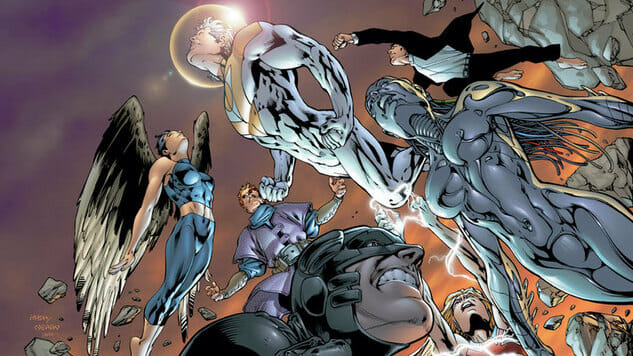
Last week, Warren Ellis and Jon Davis-Hunt kicked off The Wild Storm, a 24-issue maxi-series that reboots the occupants of the former WildStorm universe into a fresh new status quo, unrestrained by previous continuity or a mandate to exist alongside the core DCU. WildStorm, which officially folded in 2010 before the New 52 began, was always an unusual beast: breakout X-Men artist Jim Lee founded the imprint in 1992 as part of the Image exodus, only to sell it off to DC Comics in 1999 and become, at least for a time, as vital a part of DC’s diverse publishing plan as the famed Vertigo imprint. Superheroes were always core to WildStorm’s DNA, but with the move to DC, the imprint reinvented itself as a vanguard for innovation in cape comics, thanks largely to Warren Ellis’ boundary-pushing work on titles like The Authority with Bryan Hitch and Planetary with John Cassaday.
When WildStorm’s shared-universe concepts started to lag, Ellis and other creators like a then-rising Brian K. Vaughan continued to push the envelope with high-concept work outside of the WildC.A.T.S./Gen 13/Stormwatch continuity, including books like Ex Machina that continue to stay in print under a retroactive Vertigo branding. Upon the advent of the New 52, attempts were made to fold WildStorm’s original superhero characters in alongside Batman, Superman and all the rest—attempts that fell flat beyond imports Midnighter and Apollo. The Wild Storm, Ellis and Davis-Hunt’s enigmatic new sci-fi thriller, already echoes the primary draw of WildStorm’s best books: it doesn’t feel quite like any other superhero book on stands, and it’s striving to set the pace rather than follow a trend. In honor of the first issue’s release last week, Paste counted down ten of the now-defunct imprint’s greatest comics of all time. Sound off on Facebook or Twitter if we left off any of your favorites.
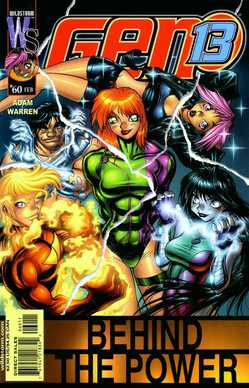 10. Gen 13
10. Gen 13
Writer: Adam Warren
Artists: Adam Warren, Rick Mays, Yanick Paquette
Gen 13 promised a whirlwind of ‘90s teen stereotypes torn between hormones and rebellion, but only embraced that promise of spunky irreverence when American manga disciple Adam Warren stepped in. The Empowered cartoonist took characters with names like Grunge and reveled in their sheer ridiculousness, starting with a story arc that features the boneheaded teen fantasizing a hyper-violent, X-rated blockbuster that ends with a tornado-propelled straw skewering a villain.
More importantly, Warren transformed the generic concept of genetically altered teens fleeing the government into something startlingly ambitious. He nailed the horny, listless bewilderment of teenhood, fitting in one-offs about sentient songs and a finale that packs a huge twist with more than a few tears. The art never quite caught up to Warren’s ideas unless he executed it himself, but this run offered one of the most unique and colorful corners of superhero comics for a brief moment. Sean Edgar
 9. Stormwatch
9. Stormwatch
Writer: Warren Ellis
Artists: Tom Raney, Bryan Hitch
This may be hard to believe at the advent of Warren Ellis and Jon Davis-Hunt’s The Wild Storm, but Stormwatch was once a series defined by aggressively superficial ‘90s cyber-machismo. Much like its cousin WildC.A.T.s—another stereotypically ‘90s book that Jim Lee probably came up with while petting a cat—it took the hiring of an esteemed writer (“The Original Writer,” some might say) to gain some form of relevance. And much like the pre-Alan Moore WildC.A.T.S., Stormwatch was filled to the brim with hyper-muscular men in battle armor indiscriminately firing energy weapons into the air (while somehow littering the ground with metal shell casings) and scantily clad femme fatales bending their bodies in impossible ways.
But when Warren Ellis and Tom Raney took over the book with Stormwatch #37, things took a turn, and Ellis’ ascendancy in the WildStorm Universe was set in motion. Ellis co-created characters like Midnighter and Apollo, who currently enjoy a modicum of prominence in the DC Universe; there was also Jack Hawksmoor, a.k.a. the “God of Cities,” and Jenny Sparks, “The Spirit of the 20th Century,” as quintessential an Ellis character as Spider Jerusalem or Elijah Snow. Stormwatch is notable for several reasons, but chief among those reasons is that it laid the groundwork for The Authority, a book that would knock on the door of the 21st Century and usher in a whole new style of comic-book storytelling. Jakob Free
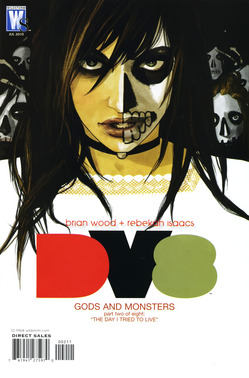 8. Dv8: Gods and Monsters
8. Dv8: Gods and Monsters
Writer: Brian Wood
Artist: Rebekah Isaacs
Dv8: God and Monsters stormed the stands like some unholy union between a Greek philosophy manifesto, a sociology text and a traditional superhero comic. The titular team—a group of dysfunctional villains who often fought the Gen 13 gang—time travels to hunter-gatherer pre-history, where each member serves as a deity to a tribe. Under the pen and design of Brian Wood, some members erect brutal military cultures, others slink into drug-and-sex communes and let’s just take a moment to appreciate that this sophisticated batshit comic even existed. The mini-series was The Wicked The Divine before The Wicked The Divine, articulated through the soft, considered realism of Rebekah Isaac’s art and stunning, minimalist covers from a pre-Saga Fiona Staples. It’s the definition of a hidden gem, and also encountered the same low-sales tragedy that greeted many other entries on this list. Warren Ellis may have accomplished huge strides in redefining the superhero during WildStorm’s early years, but works like this show a gorgeous drive to innovate in the imprint’s final days as well. Sean Edgar
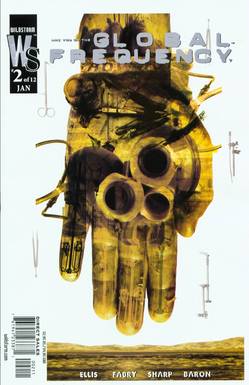 7. Global Frequency
7. Global Frequency
Writer: Warren Ellis
Artists: Garry Leach, Glenn Fabry, Steve Dillon, Roy Martinez, Jon J. Muth, David Lloyd, Simon Bisley, Lee Bermejo, Tomm Coker, Jason Pearson, Gene Ha, Chris Sprouse
Long before he resurrected the done-in-one format at Marvel with Secret Avengers and Moon Knight, Warren Ellis created Global Frequency, a 12-issue paramilitary sci-fi thriller about a covert international organization that calls upon 1,001 specialized independent operatives across the world to handle situations that major governments won’t—or can’t. Drawn by 12 different artists including the late, great Steve Dillon and V for Vendetta’s David Lloyd, Global Frequency features only two recurring characters (head spook Miranda Zero and dispatcher Aleph). Ellis cast high uncertainty whether his activated specialists would survive any given mission, with threats ranging from the transhuman to the nuclear. The book also helped introduce the comic world to writer Brian Wood, who provided cover art for the series. Ellis continued to use WildStorm as a home for shorter sci-fi and military projects like the unflinching Red with Cully Hamner and tripped-out Desolation Jones with J. H. Williams III, but Global Frequency shows him at his most mile-a-minute creatively fertile, pivoting to a new, accessible concept each issue. Steve Foxe
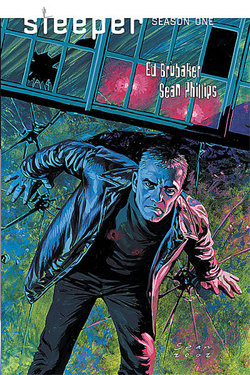 6. Sleeper
6. Sleeper
Writer: Ed Brubaker
Artist: Sean Phillips
Keeping up with all of Ed Brubaker and Sean Phillips’ excellent collaborations—Criminal, The Fade Out, Fatale, Incognito and the current Kill Or Be Killed—isn’t easy, but Sleeper shouldn’t be forgotten. This early pairing is a powerful genre-bender, a little bit superhero, a lot of spy and plenty of noir. The premise is complexly simple: Holden Carver is a superpowered secret agent sent to infiltrate the bad guys led by the creepy Tao, but Carver’s only contact with the good guys falls into a coma. Whoopsie. This leaves Carver stuck as an embedded agent forced to commit murder and various other atrocities to maintain his cover. Brubaker and Phillips make every outing distinct, but they did some exceptionally strong world-building here, particularly the way characters tell their origin stories in third-person to provide plausible deniability. Spies and capes have rarely blended so well. Mark Peters
 5. A god Somewhere
5. A god Somewhere
Writer: John Arcudi
Artist: Peter Snejbjerg
Despite a raised profile for writer John Arcudi and artist Peter Snejbjerg (both collaborate on Mike Mignola’s B.P.R.D.), 2010’s A god Somewhere remains a criminally under-mentioned WildStorm standalone tale. The framework is familiar—a man with extraordinary powers begins to use them in improper ways—but this no simple “Superman, But Evil” story. Eric, the titular “god,” is the first human on Earth to develop unexplained powers far beyond his comprehension. As his powers earn him fame and attention for his good deeds, Eric becomes more and more convinced that he is a conduit for God’s will. When things begin to unravel, they do so in spectacularly upsetting fashion, with echoes of Miracleman more than, say, Red Son or even Squadron Supreme. There are no proxy Batmen or Wonder Women waiting in the wings to bail out humanity, only very mortal, very fragile human beings trying to find what’s left of Eric behind his super strength and seeming immortality. Out of every title on this list, A god Somewhere is easily the bleakest look at what it means to be more than human, with a horrific final act that would have fit in just as easily at Vertigo as it did under the WildStorm banner—which may explain DC’s decision to retroactively label it as such. Steve Foxe
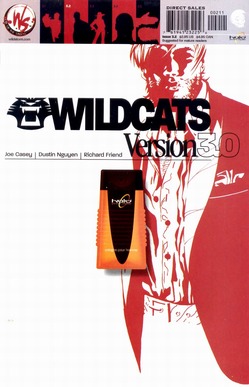 4. Wildcats Version 3.0
4. Wildcats Version 3.0
Writer: Joe Casey
Artists: Dustin Nguyen, Duncan Rouleau
Much like Adam Warren’s radical reconstruction of Gen 13, Joe Casey cast narrative magic on WildC.A.T.S., evolving Jim Lee’s post-Marvel project into one of the most underrated, provocative superhero operas available. Joined with the sleek, ergonomic designs of Dustin Nguyen, Casey reimagined the superhero as a socialist entrepreneur, mining endless energy from an alternative dimension. It was a bold move in a medium where businessmen traditionally serve as villains, but its message was bizarre and unexpected. For longtime fans, witnessing Spartan, Zealot and a crippled Grifter grow into contemplative humanitarians was just as rewarding as the cosmic battles from years past. And again: Nguyen’s Swiss, antiseptic visuals offered a mature fit for the future-forward themes, borrowing more from Apple advertising campaigns than superhero hyperbole. Sean Edgar
 3. Planetary
3. Planetary
Writer: Warren Ellis
Artist: John Cassaday
Sometimes a writer/artist team falls in perfect sync, and that’s certainly the case with Warren Ellis and John Cassaday’s 27-issue run on Planetary. The book tells the story of an organization investigating weird events across the globe, ranging from a ghostly cop seeking vengeance on the men responsible for his death to a 19th-century experiment in spaceflight to a group of adventurers whose search for a better world causes them to run afoul of superbeings from another universe. Planetary built its own mysteries, and managed to tell a gripping story while also deconstructing the history of pulp fiction across the years. The conclusion to the first major mystery posed by the book—a sequence involving lead character Elijah Snow demonstrating his own abilities on a massive scale—remains a perfectly paced sequence in scale and momentum. Tobias Carroll
 2. Ex Machina
2. Ex Machina
Writer: Brian K. Vaughan
Artists: Tony Harris, Chris Sprouse, John Paul Leon
Blending superpowers and politics isn’t an easy task, and plenty of talented creators have stumbled when trying to juxtapose realistic takes on hot-button issues with people in capes and spandex using their abilities to save the world. And while the elevator-pitch version of Brian K. Vaughan and Tony Harris’s Ex Machina is simple—“What if a superhero ran for mayor of New York City?”—the details are what make the book click. Its take on superpowers feels closer to science fiction (and, at times, horror) than anything else, and protagonist Mitchell Hundred’s idiosyncratic politics seem deeply genuine and keep the book’s conflicts fresh and interesting into the tumultuous modern day. Tobias Carroll
 1. The Authority
1. The Authority
Writer: Warren Ellis
Artist: Bryan Hitch
God willing, in the year 2099, kids will be zooming around Forbidden Planet on hover boards (real ones, dammit) rifling through the quarter bins or bitcoin bins or whatever currency exists at the time. And when these woke-AF, potentially cyborgian children cast their collective gaze over the wasteland of the previous century, they’ll perhaps notice a “post-9/11” trend in the comic-book fiction of that bygone era. If so, they will likely hone in on Warren Ellis and Bryan Hitch’s The Authority, the true epicenter of the era’s comic book, despite the fact that it debuted nearly two and half years before that fateful day.
The Orwellian-named The Authority is comprised of some of Ellis’ former Stormwatchers, along with new characters created for the book with Hitch, and their first act is a response to a massive act of international terrorism. Here, our heroes are not the shining red, white and blue boy scouts of yesteryear, but rather the members of a paramilitary outfit with very little accountability or oversight. This is also where our theoretical future children would learn about “widescreen” comics, founded in this title before Hitch exported the format to Marvel. They may even puzzle over Y2K, the faux computer logistics scare we can all comfortably laugh about now. But Ellis probably knew what was coming in the 21st Century was a whole hell of a lot worse. Jakob Free